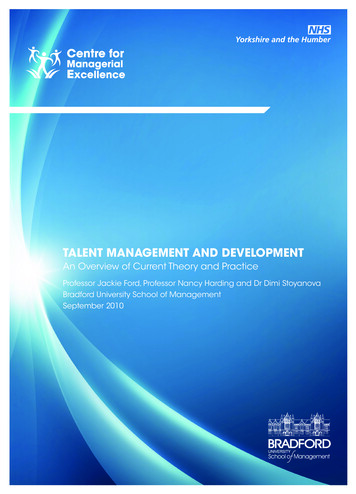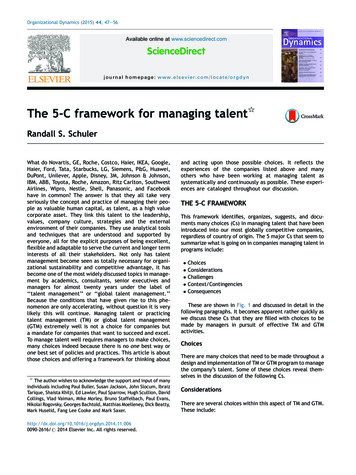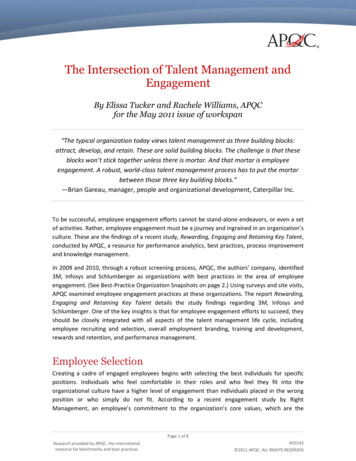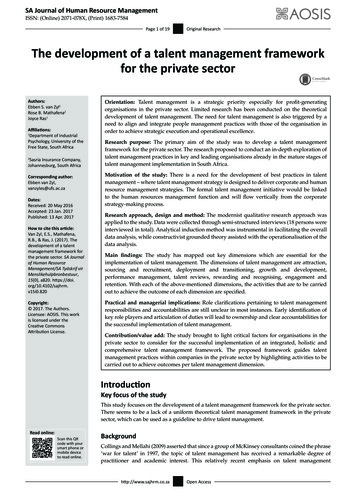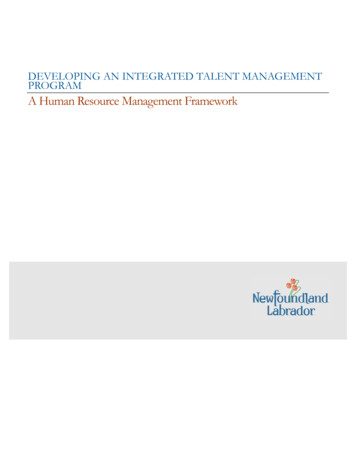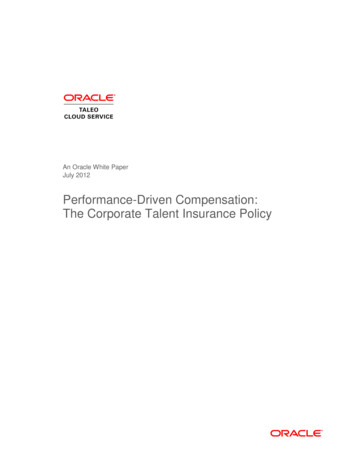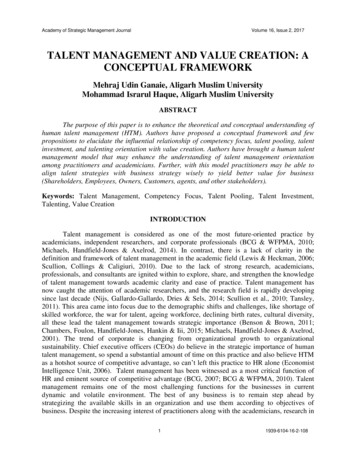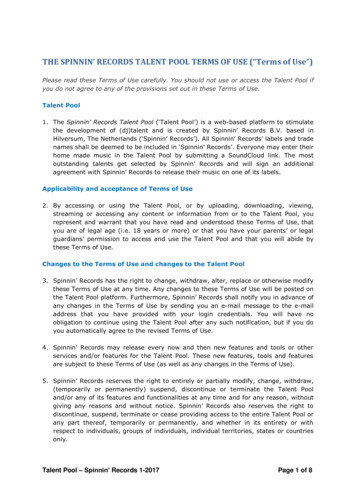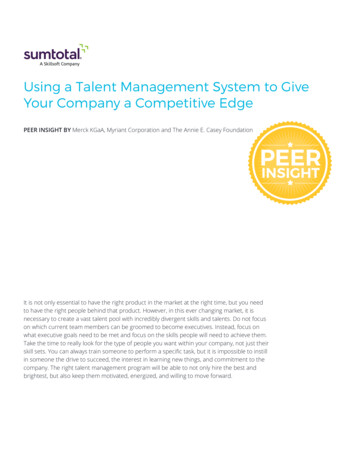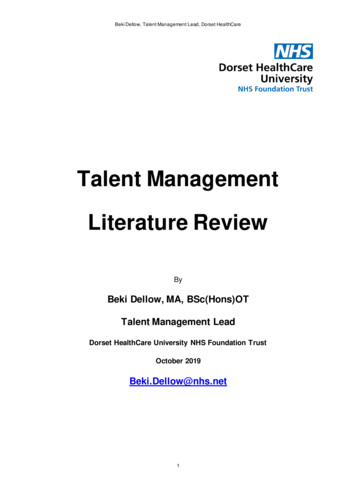
Transcription
Beki Dellow, Talent Management Lead, Dorset HealthCareTalent ManagementLiterature ReviewByBeki Dellow, MA, BSc(Hons)OTTalent Management LeadDorset HealthCare University NHS Foundation TrustOctober 2019Beki.Dellow@nhs.net1
Beki Dellow, Talent Management Lead, Dorset HealthCareContentsAbstract . 3Introduction . 3Talent Management Terminology. 4Talent. 4Talent Management (TM). 5Talent Strategy . 7Talent Development . 7Talent Pool . 8Talent Pipeline . 9Talent Bank . 9Talent Review Panel .10Succession Planning.10History of Talent Management. 10Foundations of Talent Management - Human Resources.10Inclusive versus Exclusive Talent Management Approaches .11Talent Management and the NHS .13Talent Management in Practice . 20Talent Management Today and Moving Forward . 31Talent Management Interventions .33Attracting and Recruiting Talent .34Developing Talent .35Managing Talent and Evaluating Talent .36Retaining Talent .37Conclusion. 38References . 402
Beki Dellow, Talent Management Lead, Dorset HealthCareAbstractThis article aims to offer a comprehensible summary of a range of pertinent literaturerelated to the field of Talent Management. Tansley et al (2007) stressed theimportance of organisations identifying what they mean by talent in order to begin todevelop a comprehensible Talent Management (TM) Strategy, and therefore someessential definitions/explanations are shared first to familiarise the reader with TMterminology.IntroductionThe role of Talent Management Lead is a new post which was created by DorsetHealthCare in 2019 to help drive forward and embrace the National Health Service(NHS) Long Term Plan (2019a). The plan proposed that ‘a systematic regional andlocal approach for identifying, assessing, developing, deploying and supportingtalent’ would be in place from early 2019 (NHS 2019a p89). The sole act ofrecognising and creating such a role indicates the readiness and maturity in s,reverberatingwithinDorsetHealthCare and the NHS as a whole. The purpose of the TM Lead role is to lead thedesign and implementation of a flexible and inclusive approach to TM that supportsall employees to maximise their potential; to design, develop, pilot, evaluate andimplement a flexible range of tools, opportunities, solutions and a system to drive aculture whereby all employees are able to reach their true potential and that enablesus to build strong pipelines of talent across the organisation and create and build apool of experiential development opportunities to facilitate more internal coaching,shadowing, work experience, additional responsibilities, projects and secondmentsto support the development and growth of future talent.3
Beki Dellow, Talent Management Lead, Dorset HealthCareTalent Management TerminologyTalentThe word ‘talent’ is considered an everyday term, however its application in learningand development is diverse and can understandably cause confusion (Stewart andRigg 2011). Some definitions, although not exhaustive, of ‘talent’ are shared in dateorder below to give a taste of the extent of variation and progression of the term inthe context of TM:‘Talent is inherent in each individual, one person at a time’ (Rothwell 1994 p6).‘The superior mastery of systematically developed abilities (or skills) and knowledgein at least one field of human activity, to a degree that places an individual within thetop 10% of age peers who are (or who have been) active in that field’ (Gagne 2000p67).‘Talent means everyone at all levels [working] at the top of their potential’ (Redford2005 p20).‘Talent consists of those individuals who can make a difference to organisationalperformance, either through their immediate contribution or in the longer term bydemonstrating the highest levels of potential’ (Tansley et al 2007 thepotentialtocreatedisproportionate amounts of value from the resources that the organisation makesavailable to them’ (Goffee and Jones 2009 p57).‘Talent is the combination of doing something good and doing something you like todo. This generates an automatic passion to get results. When developing talent, theright context, support and a proper fit with individual, societal and organizationalgoals is necessary’ (Flemish Government 2012 p9, cited by Buttiens andHondeghem 2012).4
Beki Dellow, Talent Management Lead, Dorset HealthCare‘Someone who has a natural ability to be good at something, especially withoutbeing taught’ (Cambridge Business English Dictionary 2019).‘We all have talent. Talent can be a natural aptitude or an acquired ability, learnt witheffort. Talent can be cultivated through use and deliberate practice. Engaging in yourtalent is an enjoyable experience that can also have positive effects on others’(Dorset HealthCare 2020).Talent Management (TM)The term ‘war for talent’ was first used by the American consultancy firm McKinsey in1997, referring to a key driver for corporate performance and the recruitment of themost valuable employees to an organisation (Stewart and Rigg 2011 p27), or inother words, Talent Management (TM). TM is considered a proactive approach tothe development of skills and careers and is particularly useful when an organisationhas difficult to fill roles due to varying reasons (Garrow and Hirsh 2008) such as thecurrent supply shortage of specific occupational groups including nurses. The NHSLeadership Academy (2016 P4) emphasised that ‘effective talent management is acritical component of NHS Strategy, since the organisation will depend on havingtalented people in a wide range of leadership, management, technical andoperational positions to achieve its objectives’. TM approaches are dependent onhow an organisation views talent and their reasons for managing talent (Stewart andRigg 2011). Various definitions/explanations of TM are shared below:‘The systematic attraction, identification, development, engagement/retention anddeployment of those individuals with high potential who are of particular value to anorganisation’ (CIPD Change Agenda 2006; Tansley et al 2007 p9).‘A comprehensive and integrated set of activities to ensure that the organisationattracts, retains, motivates and develops the talented people it needs to now and inthe future’ (Baron and Armstrong 2007).5
Beki Dellow, Talent Management Lead, Dorset HealthCare‘About positive things – doing things for your best people, investing in developingthem, building on potential and, therefore, helping people make the best use of theirstrengths and improve on their weaknesses’ (Garrow and Hirsh 2008 p389).‘Enhancing of an employee’s ability to cope with changing work demands’ (Garavanet al 2009 p267).‘A set of organisational processes designed to ensure an effective flow of humanresources, including leadership resources’ (Garavan et al 2009 p266).‘Talent management is an integral set of processes, programs and cultural norms inan organization designed and implemented to attract, develop, deploy and retaintalent to achieve strategic objectives and meet future business needs’ (Silzer andDowell 2010 p18).‘The recognition and acceptance that all employees have talent, together with theon-going evaluation and deployment of employees in positions that give the best fitand opportunity (via participation) for employees to use those talents’ (Swailes et al2014 p5).To further add to the understanding of TM and to guide potential interventions, Silzerand Dowell (2010 p96) developed the Integrated Talent Management Model (seefigure 1 below). This is considered a comprehensive Model with interconnectedprocesses which align well with organisational culture and values (Csilla and Klar2018).6
Beki Dellow, Talent Management Lead, Dorset HealthCareIdentify Strategy Recruitment and StaffingSelectionTalent ReviewSuccession PlanningRecruitment and StaffingTalentStewardshipBusiness strategyHuman resource strategyRecruitment and StaffingAccess Performance ManagementLeadership AssessmentsMulti-rater FeedbackEngagement SurveysDevelopRetain Leadership EngagementRetention AnalysisDifferentiated RewardsMeasuring Effectiveness Development PlanningExecutive DevelopmentEducationLeadership skillsCareer PlanningTalent MovementCoaching and MentoringEarly Career ProgramsFigure 1 – Integrated Talent Management Model (Silzer and Dowell 2010 p96)Talent StrategyPreparation of a Talent Strategy should be an ever changing, dynamic processwhich is based on ‘iteration, dialogue, challenge and response’ (Tansley et al 2007p12), and aligned closely with other relevant corporate strategies. The Strategy mustbe well-defined, and aim to address three key areas of enquiry including: ‘what’ partof the organisation (e.g. types of job role), ‘where’ and ‘when’ in of the organisationor outside of it (e.g. what areas need immediate focus such as those with hard torecruit posts and when are these needed by), and ‘what’ does the organisation wantto focus on with regards to development outcomes (e.g. goal setting to guideidentification of existing talent pools and recruitment needs) (Garrow and Hirsh 2008p391).Talent Development‘Talent development focuses on the planning, selection and implementation ofdevelopment strategies for all or part of the talent pool to ensure that the7
Beki Dellow, Talent Management Lead, Dorset HealthCareorganisation has both the current and future supply of talent to meet strategicobjectives and that development activities are aligned with organisational talentmanagement processes’ (Bratton et al 2017).‘Talent development pathways are the career steps that are required to progress tomore senior roles. It is acknowledged that there may be some variation in pathwaysbetween organisations depending on what is needed to meet models of care andpatient pathways’ (DH 2007 p21).Talent Pool‘A talent pool describes a collective of talented employees who have been identifiedas talented. They can take different forms, have different memberships and be usedfor example as a means of resourcing project work, secondments, and internalrecruitment’ (Tansley et al 2007 p9).‘A talent pool is a term for a collective resource of talented employees, with selectionfor membership of a talent pool being based on performance review, assessmentcentre, 360-degree appraisal or line manager nomination’ (Pilbeam and Corbridge2010 p103).A variety of methods can be used to place employees in specific talent pools such asthe appraisal/performance review process, the 360-degree appraisal, managementnomination and learning and development centres/training cohorts. However, it isimportant that the selection process is transparent and that the talent pools are‘dynamic entities’ which ‘flex and change depending on business requirements’(p25). In their case-study, Tansley et al (2007 p25) highlighted various types of talentpool, such as just one individual designated talent pool; several designated talentpools with different memberships; no formal designated talent pool, but nonethelessa pool of talent built up as a result of talent management activities, or like Google,universal talent pools with different ‘streams’ reflecting its inclusive ‘open to all’approach to TM (e.g. one stream consists of customer service staff, and another has8
Beki Dellow, Talent Management Lead, Dorset HealthCareIT specialists who develop new products). They also shared that some organisationsclassified different talent pools including rising stars, local talent, emerging leadersand exceptional talent (see figure 2 below for an example of a talent pool hierarchywhich may be usual within Health and Social Care settings):Executive talentRising starsEmerging talentEntry-level talentFigure 2 – Talent Pool Hierarchy (Tansley et al 2007 p26)Talent Pipeline‘The talent management pipeline refers to the different elements that make up thetalent management process which includes acquiring, retaining, developing andmanaging of individuals identified as talent. The talent pipeline can provide aframework to inform the design and application of systems for tracking talent andmeasuring talent management interventions’ (Tansley et al 2007 p9).Talent Bank‘A talent bank consists of speculative enquiries and also applications retained fromprevious recruitment activity, and provides a pool of potential candidates that can beaccessed when a vacancy occurs’ (Pilbeam and Corbridge 2010 p171).9
Beki Dellow, Talent Management Lead, Dorset HealthCareTalent Review Panel‘A talent review panel is a group of individuals drawn from across an organisationwhich includes representatives from senior management, line management and theHR function, as well as individuals with particular expertise in the area. Theresponsibilities of the panel could involve reviewing the selection of individuals intothe talent pool, tracking their progress, evaluating the success of talent managementinitiatives across the organisation and identifying areas for future action andadaptation’ (Tansley et al 2007 p9).Succession Planning‘A management process by which one or more successors are identified for keyposts (or groups of similar key posts) and career moves and/or developmentactivities are planned for these successors’ (Hirsh 2000).‘The planned replacement of key staff’ (Tansley et al 2007 p10).History of Talent ManagementIn order to gain a greater understanding of Talent Management (TM), exploring thehistorical context of how the NHS first began to adopt and develop this approach isessential. An informative article by Macfarlane et al (2012) is intertwined throughoutthis section as it provides a critical analysis of the role of managerial TM and thesuitability of this approach, which was initially adopted by the NHS three decadesago, but has only recently become a high priority and is picking up impetus andsignificance.Foundations of Talent Management - Human ResourcesFirstly, in order to clarify where TM has historically been aligned with humanresources (HR), it is important to visit human resource management (HRM)literature, which has been described as differentiating between ‘soft’ approaches10
Beki Dellow, Talent Management Lead, Dorset HealthCarebased on ‘developmental humanism’ and ‘hard’ approaches based on ‘utilitarianinstrumentalism’ (Storey 1987; Legge 2005 p66). Hard HRM is typically regarded asthe management of human resources, with the emphasis being on the ‘resources’ ofan organisation, whereas soft HRM emphasises the development of resourcefulhumans, with the concentration being on ‘humans’ (Macfarlane et al 2012 p446).Hard HRM is emphasised by Storey (1987 p6) to be the ‘quantitative, calculative,and business strategic aspects of managing the headcount resource in as rational away as for any other factor’. In other words, individuals are considered more of acommodity and are not recognised fully as a whole person but as assets of theorganisation; their skills and attributes that the organisation requires are of mainconcern (Storey 1987; Legge 2005). In contrast to this, soft HRM encompassesparallels to the high performance work systems approach (HPWS), which Beckerand Huselid (1998 p54) described as reflecting a ‘new interest in people as a sourceof competitive advantage, rather than a cost to be minimised’. They defended that inorder to ‘attract, develop and retain’ a motivated, skilled and highly performingworkforce, the HPWS approach focuses not only on the organisational systems, butalso values and develop the ‘intellectual assets’ (employees) of an organisation, asboth are significant and essential in strategic decision making and optimalpositioning of staff to meet internal and external needs. This older attitude is stillstrongly aligned to TM, which has been more recently considered to be a part of HRactivity (Macfarlane et al 2012).Inclusive versus Exclusive Talent Management ApproachesOn a continuum, at one extreme, TM is mostly considered to be fully ‘inclusive’ andis often referred to as ‘humanistic TM’. An inclusive TM approach focuses on thetalents of everyone in the workforce holistically and the management of these talentswithin an organisation, or in other words ‘soft TM’. The opposing extreme tends tofocus on a select ‘exclusive’ workforce such as senior management or ‘top leaders’,also referred to as ‘hard TM’ (Tansley et al 2007; Pilbeam and Corbridge 2010;Macfarlane et al 2012 p446; Swailes et al 2014; Taylor 2014; Bolander et al 2017p1530). Stewart and Rigg (2011 p185) gave further explanation of the differencebetween inclusive and exclusive TM, stating that when talent is seen as ‘position’within an organisation, it will put more focus on role development needs, whereas11
Beki Dellow, Talent Management Lead, Dorset HealthCarethe focus of talent as the ‘individual’ will prioritise attention to the individual-leveldevelopment need. They also proposed that ‘defining talent in relation to positions ismore likely to lead to exclusive approaches and defining talent as individuals is morelikely to lead to inclusive approaches’ (p186). It is clear from the literature reviewedthat TM is a concept which is multi-dimensional and there are a range of views anduses of the terminology. However, it is evident there is no right or wrong TMapproach, and sometimes a ‘blended perspective’ or blended approach is adoptedby an organisation which is neither excessively exclusive nor too constricted in itsconcept (Stewart 2014 p7). To help summarise, the strengths and weaknesses to an‘inclusive’ TM approach is offered below in figure 3,and the strengths andweaknesses to an ‘exclusive’ TM approach in figure 4 later:StrengthsWeaknessesWider employeeengagement if the entireorganisation has access toa talent poolLearning and developmentand other resources arespread to thinlySupports successionplanning place for all keyroles, not just seniormanagementIncreased competition forprogression whichrequires managingEncourages thedevelopment of a morediverse workforceIndividuals with skills coreto the business mayreceive less investment, tothe detriment of theorganisation's strategicgoalsMore opportunitiy tobenefit from all the talentsof the workforceFigure 3 – Strengths and weaknesses of an ‘inclusive’ Talent Management approach (Tansley et al 2007 p22)12
Beki Dellow, Talent Management Lead, Dorset HealthCareWeaknessesStrengthsProvides an identifiable,strategic resource forsuccession planning if aimedat the future leaders of theorganisationHigh potential for reducedengagement and increasedturnover among staff notincluded in a designatedtalent poolTargets finite resources financial and non-financialLess scope to increasediversityMore opportunity to offerindividualised developmentprogrammes to the talentpoolReduced developmentopportunities and resourcesfor employees not on a talentprogrammeEasier to track and evaluatebenefitsIf focused upon oneoccupational group or grade,other types of talent may beoverlookedFigure 4 – Strengths and weaknesses of an ‘exclusive’ Talent Management approach (Tansley et al 2007 p21)Talent Management and the NHSThe study by Macfarlane et al (2012) referred to earlier, offered a more detailedhistory of ‘soft TM’ and it’s relation to the NHS dating back as far as the 1940’s,when it was recognised that the NHS would need a more formalised way ofemploying and educating the administration staff to lead the service. Later, in the1950’s; the Hospital Administrative Staff College of the King Edward’s Hospital Fundfor London (now known as the King’s Fund) delivered training schemes to developnurses, administration and catering staff to fill more senior positions over a period oftime within the NHS. In 1956, the Ministry of Health set out more details of thisscheme, stating it’s goal was to ‘provide for the selection and training for senior postsof the younger officers in the hospital who are showing promise; the recruitment and13
Beki Dellow, Talent Management Lead, Dorset HealthCaretraining annually of a small number of university graduates and other professionallyqualified entrants who are attracted to the hospital service as a career and whomight be expected to be capable of future promotion to senior posts’. 14 traineescommenced this scheme in September 1956 (Saunders 2006).Thirty years later, in the 1980’s and moving into the 1990’s, a shift in TMunderstanding was seen with the emergence of more formal TM strategies within theNHS. These were developed and encouraged by the UK Government, and based onthe private sector management approaches which included a focus on leadershipculture, building on the more traditional public sector practices used by the NHS atthat time (Grint 2000). The NHS Training Authority, later renamed ‘The NationalTraining Scheme’, took over responsibility for the NHS management training schemein 1983 following a report that incorporated an overt strategy of adopting anincreasingly business-like approach to management and leadership in the NHS. Itsprimary aim was to increase efficiency and decrease disparity and waste. Thisstrategy included employing private sector senior leaders and also aimed to ensuremanagers were more proactive and visible (DHSS 1983).In 1997, the NHS published its first white paper under Labour Government: The NewNHS: Modern, Dependable (Department of Health (DH) 1997). This paper aimed todrive forward the vision of modernising the NHS, with a new public managementapproach which incorporated replacement of the internal market and aimed toextend many aspects of this market orientation, moving towards firmer accountabilitystructures, central reporting and a greater emphasis on connecting peoplemanagement and workforce planning. The NHS Modernisation Agency soon becamepart of the infrastructure to put this into operation, with the primary focus being onthe strategic aims of ensuring a well-organised quality workforce with the right skills,diversity and numbers of employees to deliver the Government’s service objectivesfor social care and health, along with evidencing that the quality of working life for allstaff was improving, and that there was the management capability and capacityneeded to deliver this agenda and changes (DH 1999; DH 2000).14
Beki Dellow, Talent Management Lead, Dorset HealthCareIt wasn’t until the subsequent consultation document: A Health Service of All Talents(DH 2000), where the use of the terminology ‘talent’ was introduced. This paper’sfocus was primarily geared towards workforce planning for the future, with newapproaches to working proposed including the breaking down of barriers to enhancethe contribution of all staff towards patient care, rather than being limiting by insistingthat only specific staff could deliver certain types of treatment. Education and trainingmodernisation was proposed to ensure staff had the right skills and knowledge towork in an ever changing and complex NHS. Expanding the workforce to meet thedemands of the future was proposed by creating more flexible careers and workingarrangements for all staff to make the optimum use of their abilities. Multi-disciplinaryteam working was promoted across organisational and professional boundaries andworkforce planning was suggested which was streamlined and linked to the needs ofpatients, and not the professionals’ needs.A later white paper: Liberating the Talents: Helping Primary Care Trusts and nursesto deliver the NHS Plan (DH 2002), was published by the Department of Health in2002, and offered a strategic direction and framework to plan and explain the newways of working and how extending the roles of front line staff such as midwives,health visitors and nurses in advanced practice could help to improve and promoteintegrated health care and the overall health of the population. The objective was toliberate the skills and talents of the entire workforce, encouraging creativity andinnovation, whilst again focusing on breaking down traditional boundaries to ensurethat every patient would have ‘the right care in the right place at the right time’ (DH2002 p3). A recruitment and retention programme was also incorporated to improvethe working environment.In 2005, major changes occurred with NHS management and leadership trainingschemes, demonstrating a growing focus on TM, with the development of a NationalTM team. The NHS Institute for Innovation and Improvement took over this role andsubsequently increased the uptake in NHS Management Trainees scheme from 70to 90, reflecting the increasing need from the growing NHS at that time (Macfarlaneet al 2012).15
Beki Dellow, Talent Management Lead, Dorset HealthCareA few years later, Gander (2008) produced an article for the Health Service Journalwhich shared the NHS workforce director’s view regarding the need for the NHS to‘attract great leaders into the service and unleash the full potential of those it alreadyhas’. The necessity to identify and develop NHS talent with assertive ‘talent spotting’and the identification of future leaders were made a priority, as the NHS Strategythree years previous had failed to centralise TM through a separate National Body.Therefore, although this level of TM had its issues, devolution of implementation wassplit into regions and the need to collaborate was highlighted with a systematicapproach to remove barriers to moving talented staff around the NHS and developtalent. Also in 2008, the NHS High Quality Care for All: Next Stage Review FinalReport was delivered, in which Lord Darzi cited that the ‘unlocking of the talents offrontline staff’ was required to deliver high quality care, promote partnership workingand empowering them to lead on change and the management of the organisationsthey work in (DH 2008b p13). Further aims of the guideline were to ‘foster apioneering health service that makes the best use of talents of NHS staff, the highereducation sector and industry’ (DH 2008b p56), whilst also reflecting that theInternational evidence base from the Far East, North America and continentalEurope had proved that the bringing together of talents from different sectors hadbenefitted patients. In addition to TM, the establishment of a system-wide bodycalled the NHS Leadership Council was given priority for development to oversee allleadership matters across healthcare including the development of 250 leaders (DH2008a; DH 2008b).It was around ten years ago that TM eventually became more prevalent within theNHS, with the publication of the paper: Inspiring Leaders: Leadership for Quality (DH2009) which aimed to provide a best practice framework to be used to develop talentand leaders across health care. This guidance acknowledged that the NHS had notyet fully grasped the importance of identifying, nurturing and promoting talent andleadership; however it emphasised that taking the next step forward was critical inorder to fully embrace more people with different backgrounds and skills and supporttheir development in a sustainable way, whilst embracing change management. Itwas stressed that ‘creating a shift in NHS culture’ (DH 2009 p7) was needed if talentand leadership were able to contribute fully to improving quality. The main16
Beki Dellow, Talent Management Lead, Dorset HealthCareresponsibility for improving talent and leadership capability and capacity would liewith local employers; yet the four Strategic Health Authorities (SHAs) at that timewere also tasked with forming the right conditions across their region for the talentand leadership plans that would ultimately lead to this t
2009) which aimed to provide a best practice framework to be used to develop talent and leaders across health care. This guidance acknowledged that the NHS had not . talent strategy and talent management processes can be launched. In addition, a language for talent management activities that is understood by .

